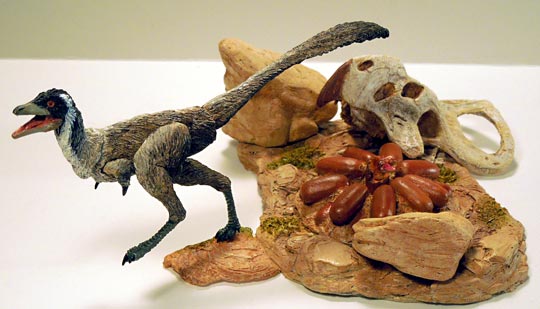“Beep-Beep” – Its a Dinosaur Road Runner (Xixianykus)
New Fast Running Dinosaur Discovered in China (Xixianykus zhangi)
Scientists have described a new species of fast running dinosaur from China. The dinosaur has been named Xixianykus zhangi.
Heralded as a sort of dinosaur equivalent of the cartoon bird roadrunner, scientists have announced the discovery of a new type of fast running theropod dinosaur. This tiny creature with short thigh bones and long lower leg bones seems to have been built for speed. Being agile and able to run fast would have been extremely handy for this 50 cm long dinosaur, despite not having to worry about “Wile E Coyote” there would have been plenty of predators wanting to put Xixianykus on the menu.
Remains of this new species were found in the spring of 2009 by a local farmer in China’s Henan Province (eastern China) an area already famous for its Cretaceous dinosaur fossils. The strata from which the incomplete fossil of this new dinosaur was found dates from approximately 85 million years ago (Santonian faunal stage). A paper on this new dinosaur, believed to be an alvarezsaurid has been published in the scientific journal “Zootaxa”.
Alvarezsaurids
Alvarezsaurids are a bizarre group of theropod dinosaurs, known from fossils found in China and south America. Typically small, with even the largest specimens known such as Alvarezsaurus (from which the group gets its name) and Patagonykus being less than 2 metres long (and most of this length is tail), this is a very enigmatic branch of the Dinosauria. However, classifying alvarezsaurids as dinosaurs is not that straight forward. They have many bird-like features, such as specialised forelimbs, breast bones, fused ankles and narrow skulls. Most likely feathered, to help insulate them and keep these small, active animals warm (no evidence of alvarezsaurids evolving the ability to fly), it is believed these animals inhabited forests and open plains. The short thighs, long shins and feet are indicative of a cursorial lifestyle and suggest that these creatures were very fast runners indeed. This new partial specimen, now formerly named Xixianykus zhangi, although just over half a metre long, had proportionately very long lower legs, indicating that it was a very fast runner. With legs measuring 25 cm long these were extreme, even for the lightly built fast running Alvarezsauridae.
An Illustration of the new Alvarezsaurid (Xixianykus zhangi)

Picture credit: Matt Van Rooijen
Xixianykus zhangi
Commenting on the ratio of the upper leg bones to the lower leg bones, palaeontologist David Hone of the Chinese Academy of Sciences (Beijing), one of the scientists responsible for the study of this new dinosaur said:
“These proportions imply it could put great long strides in and move fast.”
Although the forelimbs have been lost it is likely that it had short, stubby arms with a single digit on each hand. The digit had a massive claw on it, this and the arms are adaptations to a very specialised lifestyle. Scientists believe that the forelimbs were adapted to digging, perhaps these little dinosaurs were specialist insectivores, breaking into termite mounds and feeding on the insects contained within.
Features of the vertebrae and the pelvic area support the idea of Xixianykus being a dinosaur adapted for digging.
David Hone stated:
“The front of the body is adapted not to twist, which saves energy when running and provides a brace for digging actions”.
X. zhangi was most likely an endurance runner, using minimal energy to cover long distances in its search for food. It may have lived in flocks, although there is no fossil evidence as yet to support this hypothesis.
With its long, slender legs it would have had the ability to run away from trouble should any Cretaceous predator decide to try to catch it.
A Model of a Typical Aalvarezsaurid

The amazing desert accessory pack featuring a replica of an alvarezsaurid – Mononykus (Beasts of the Mesozoic).
To view the Beasts of the Mesozoic model range: Beasts of the Mesozoic Articulated Dinosaur Models.
Everything Dinosaur acknowledges the assistance of a media release from the Chinese Academy of Sciences (30th March 2010) in the compilation of this article.

